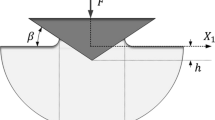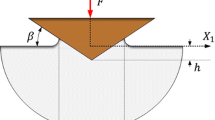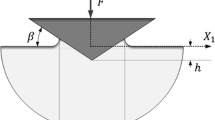Abstract
Sharp indentation test have been studied very frequently in recent years and the fundamental knowledge of the mechanics of such test has reached some maturity. Such studies also include the correlation between residual stresses and the global properties, i.e., hardness and size of the contact area. The investigations presented have been based on experimental, theoretical, and numerical methods and as a result, the basic features of the problem are fairly well understood but quantitative relations, for the determination of residual stresses using sharp indentation, have been proven to be less accurate and accordingly not suitable for a practical situation, in particular so at predominantly compressive residual stresses. It is therefore the aim of the present study to investigate this matter in some detail and to determine possible mechanisms for the difference in indentation behavior between tension and compression and, with this as a background, determine relations suitable for a quantitative determination of the residual fields. The present analysis is based on theoretical and numerical methods and in the latter case, the finite element method is relied upon. Classical Mises elastoplastic material behavior is assumed throughout the investigation.















Similar content being viewed by others
References
Marshall, D.B., Lawn, B.R.: Indentation of brittle materials. ASTM Spec. Tech. Publ. 889, 26–46 (1985)
Hehn, L., Zheng, C., Mecholsky, J.J., Hubbard, C.R.: Measurements of residual-stresses in Al2O3/Ni laminated composites using an X-ray-diffraction technique. J. Mater. Sci. 30, 1277–1282 (1995)
Rendler, N.J., Vigness, I.: Hole-drilling strain-gauge method of measuring residual stresses. Exp. Mech. 13, 45–48 (1973)
Flavenot, J.F., Nikulari, A.: Measures des contraintes residuelles, method de la fleche. Mem. Techn. du Cetim. 31, 6–42 (1977)
Kokubo, S.: On the change in hardness of a plate caused by bending. Sci. Rep. Tohuko Imp. Univ. Ser. 1(21), 256–267 (1932)
Sines, G., Carlson, R.: Hardness measurements for determination of residual stresses. ASTM Bull. 180, 357 (1952)
Pethica, J.B., Hutchings, R., Oliver, W.C.: Hardness measurements at penetration depths as small as 20 nm. Philos. Mag. A48, 593–606 (1983)
Doerner, M.F., Gardner, D.S., Nix, W.D.: Plastic properties of thin films on substrates as measured by submicron indentation hardness and substrate curvature techniques. J. Mater. Res. 1, 845–851 (1986)
LaFontaine, W.R., Yost, B., Li, C.Y.: Effect of residual stress and adhesion on the hardness of copper films deposited on silicon. J. Mater. Res. 5, 776–783 (1990)
LaFontaine, W.R., Paszkiet, C.A., Korhonen, M.A., Li, C.Y.: Residual stress measurements of thin aluminum metallizations by continuous indentation and X-ray stress measurement techniques. J. Mater. Res. 6, 2084–2090 (1991)
Tsui, T.Y., Oliver, W.C., Pharr, G.M.: Influences of stress on the measurement of mechanical properties using nanoindentation. Part I. Experimental studies in an aluminum alloy. J. Mater. Res. 11, 752–759 (1996)
Bolshakov, A., Oliver, W.C., Pharr, G.M.: Influences of stress on the measurement of mechanical properties using nanoindentation. Part II. Finite element simulations. J. Mater. Res. 11, 760–768 (1996)
Suresh, S., Giannakopoulos, A.E.: A new method for estimating residual stresses by instrumented sharp indentation. Acta Mater. 46, 5755–5767 (1998)
Carlsson, S., Larsson, P.L.: On the determination of residual stress and strain fields by sharp indentation testing. Part I. Theoretical and numerical analysis. Acta Mater. 49, 2179–2191 (2001)
Carlsson, S., Larsson, P.L.: On the determination of residual stress and strain fields by sharp indentation testing. Part II. Experimental investigation. Acta Mater. 49, 2193–2203 (2001)
Johnson, K.L.: The correlation of indentation experiments. J. Mech. Phys. Solids 18, 115–126 (1970)
Johnson, K.L.: Contact Mechanics. Cambridge University Press, Cambridge (1985)
Lee, Y.H., Kwon, D.: Measurement of residual-stress effect by nanoindentation on elastically strained (100) W. Scr. Mater. 49, 459–465 (2003)
Lee, Y.H., Kwon, D.: Stress measurement of SS400 steel beam using the continuous indentation technique. Exp. Mech. 44, 55–61 (2004)
Lee, Y.H., Kwon, D.: Estimation of biaxial surface stress by instrumented indentation with sharp indenters. Acta Mater. 52, 1555–1563 (2004)
Huber, N., Heerens, J.: On the effect of a general residual stress state on indentation and hardness testing. Acta Mater. 56, 6205–6213 (2008)
Heerens, J., Mubarok, F., Huber, N.: Influence of specimen preparation, microstructure anisotropy, and residual stresses on stress–strain curves of rolled Al2024 T351 as derived from spherical indentation tests. J. Mater. Res. 24, 907–917 (2009)
Swadener, J.G., Taljat, B., Pharr, G.M.: Measurement of residual stress by load and depth sensing indentation with spherical indenters. J. Mater. Res. 16, 2091–2102 (2001)
Larsson, P.L.: Influence from the inclined angle of the indenter for determination of residual stress and strain fields by sharp indentation testing. J. Mater Proc. Technol. 184, 372–378 (2007)
Bocciarelli, M., Maier, G.: Indentation and imprint mapping method for identification of residual stresses. Comput. Mater. Sci. 39, 381–392 (2007)
Larsson, P.L.: On the mechanical behavior at sharp indentation of materials with compressive residual stresses. Mater. Des. 32, 1427–1434 (2011)
ABAQUS: User’s Manual Version 6.9. Hibbitt, Karlsson and Sorensen Inc., Pawtucket, RI (2009)
Tabor, D.: Hardness of Metals. Cambridge University Press, Cambridge (1951)
Atkins, A.G., Tabor, D.: Plastic indentation in metals with cones. J. Mech. Phys. Solids 13, 149–164 (1965)
Larsson, P.L.: Investigation of sharp contact at rigid plastic conditions. Int. J. Mech. Sci. 43, 895–920 (2001)
Eriksson, C.L., Larsson, P.L., Rowcliffe, D.J.: Strain-hardening and residual stress effects in plastic zones around indentations. Mater. Sci. Eng. A340, 193–203 (2003)
Giannakopoulos, A.E., Larsson, P.L.: Analysis of pyramid indentation of pressure sensitive hard metals and ceramics. Mech. Mater. 25, 1–35 (1997)
Carlsson, S., Biwa, S., Larsson, P.L.: On frictional effects at inelastic contact between spherical bodies. Int. J. Mech. Sci. 42, 107–128 (2000)
Larsson, P.L.: Modelling of sharp indentation experiments: some fundamental issues. Philos. Mag. 86, 5155–5177 (2006)
Giannakopoulos, A.E., Larsson, P.L., Vestergaard, R.: Analysis of Vickers indentation. Int. J. Solids Struct. 31, 2679–2708 (1994)
Larsson, P.L., Söderlund, E., Giannakopoulos, A.E., Rowcliffe, D.J., Vestergaard, R.: Analysis of Berkovich indentation. Int. J. Solids Struct. 33, 221–248 (1996)
Larsson, P.L., Giannakopoulos, A.E.: Tensile stresses and their implication to cracking at pyramid indentation of pressure-sensitive hard metals and ceramics. Mater. Sci. Eng. A254, 268–281 (1998)
Storåkers, B., Biwa, S., Larsson, P.L.: Similarity analysis of inelastic contact. Int. J. Solids Struct. 34, 3061–3083 (1997)
Bucaille, J.L., Felder, E., Hochstetter, G.: Mechanical analysis of the scratch test on elastic and perfectly plastic materials with three-dimensional finite element modeling. Wear 249, 422–432 (2001)
Holmberg, K., Laukkanen, A., Ronkainen, H., Wallin, K., Varjus, S.: A model for stresses, crack generation and fracture toughness calculation in scratched TiN-coated steel surfaces. Wear 254, 278–291 (2003)
Bucaille, J.L., Felder, E., Hochstetter, G.: Experimental and three-dimensional finite element study of scratch test of polymers at large deformation. J. Tribol. 126, 372–379 (2004)
Wredenberg, F., Larsson, P.L.: On the numerics and correlation of scratch testing. J. Mech. Mater. Struct. 2, 573–594 (2007)
Bellemare, S.C., Dao, M., Suresh, S.: Effects of mechanical properties and surface friction on elasto-plastic sliding contact. Mech. Mater. 40, 206–219 (2008)
Wredenberg, F., Larsson, P.L.: Scratch testing of metals and polymers: experiments and numerics. Wear 266, 76–83 (2009)
Author information
Authors and Affiliations
Corresponding author
Rights and permissions
About this article
Cite this article
Rydin, A., Larsson, PL. On the Correlation Between Residual Stresses and Global Indentation Quantities: Equi-Biaxial Stress Field. Tribol Lett 47, 31–42 (2012). https://doi.org/10.1007/s11249-012-9959-y
Received:
Accepted:
Published:
Issue Date:
DOI: https://doi.org/10.1007/s11249-012-9959-y




